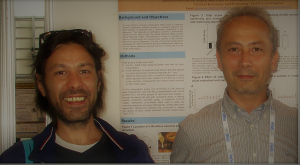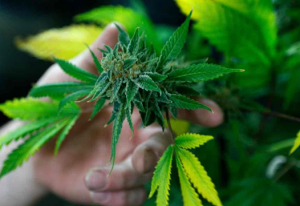Marijuana has been used by humans for over 5,000 years for religious, spiritual, recreational and medicinal reasons. Even so, the link between marijuana and epilepsy was only made in the 20th century and here, PROFESSOR GIUSEPPE DI GIOVANNI tells us how he is furthering the research on that connection.

Dr Roberto Colangeli & Professor Giuseppe Di Giovanni
It’s one of the hottest topics on the national agenda, one of the most fiercely-debated drugs in medicine, and one of the most widely-used recreational drugs out there. But Cannabis – also known as Marijuana – could help relieve the effects of a very common condition that affects the human brain.
“Epilepsy affects about 50 million people worldwide,” says Professor Giuseppe Di Giovanni, a professor of Physiology & Biochemistry within the Faculty of Medicine & Surgery at the University of Malta. “Those affected get regular seizures, which are bursts of electrical activity in the brain that temporarily affect how it works.
“These seizures can cause a wide range of symptoms, depending on which part of the brain is involved. Possible symptoms include uncontrollable jerking and shaking (called a ‘fit’), losing awareness and staring blankly into space, becoming stiff, experiencing strange sensations (such as a ‘rising’ feeling in the tummy, unusual smells or tastes, and/or a tingling feeling in your arms or legs), collapsing, and, sometimes, even passing out completely. The condition can start at any age, but usually starts either in childhood or in people aged over 60, and it’s often lifelong.”
More than just experiencing the psychical manifestations of epilepsy, those who suffer from the condition also go through psychological hardships as the condition is both unpredictable and detrimental to their health in general. However, in the 20th Century, a link between marijuana and the management of epilepsy was discovered, and Professor Di Giovanni and his team are now at the forefront of the research, particularly as they have made some very considerable contributions to the field of medical marijuana.
“For our study, we first focused on temporal lobe epilepsy using a synthetic cannabinoid showing that it was even more effective than the epileptic drug ‘phenytoin’,” he reveals. “The only problem with this treatment was that the dose of cannabinoid that was antiepileptic impaired the hippocampus [an important part of the brain linked to learning and memory].”
To overcome this side effect, Professor Di Giovanni and Dr Roberto Colangeli (who, at the time, was a post-doc in Malta), tried a compound that blocked the breakdown of the natural cannabinoids our brain normally produces. This drug then boosted the amount of the naturally-occurring cannabinoids in epileptics’ brains.
“Unfortunately, this strategy was less effective in stopping epilepsy but was longer-lasting and without major side-effects,” he continues. “For this reason, we are now following this line of intervention, trying other drugs that increase the levels of our own cannabinoids when and where they are needed to avoid any possible side effects.”
Moreover, the team is also currently investigating the status epilepticus: a life-threatening condition in which one epileptic fit follows the other without the sufferer recovering consciousness.
In some experiments conducted by Dr Roberto Colangeli, who has now moved to the University of Calgary in Canada, one important and unexpected discovery was made: Synthetic cannabinoids only had a modest effect on the development of seizures.
“When serotonin [an important neurotransmitter] was activated, the effectiveness of synthetic cannabinoids was multiplied, stopping the fits,” Di Giovanni explains. “Furthermore, we have discovered an important interaction between cannabinoids and serotonin and, at the moment, we are investigating various possibilities… We believe that the outcome could be important for furthering our understanding of the pathological mechanisms and for new treatments.”

Of course, one problem remains: the side-effects of marijuana. In fact, the U.S. Food and Drug Administration (FDA) has not yet found marijuana safe or effective for treating any health problems. And, while some countries over the world and some US States allow its use for certain health purposes, medical marijuana has been legalised because of decisions made by voters or legislators, not because of scientific evidence of its benefits and risks.
“Cannabis, as with other drugs of abuse, produces several detrimental effects on brain function but, differentially from alcohol, nicotine, cocaine, heroin and ecstasy (just to cite the most commonly abused ones), these are mostly present with acute intoxication and disappear after termination of drug intake, at least in adults,” Di Giovanni explains.
“There are also legal issues surrounding access to cannabis, as well as some scientific research on the usefulness and safety of marijuana as a treatment for seizures. Additionally, when different substances containing phytocannabinoids such as tetrahydrocannabinol (THC) and cannabidiol (CBD) are used, the effect could be a treatment-resistant form of epilepsy.”
What this will mean in the long-run for the researchers, those suffering from epilepsy, and for medical marijuana to be legalised and approved is not certain. Yet, the research goes on unabated as Professor Di Giovanni and his team collaborate with medicinal chemists in Italy and pharmaceutical companies in Malta for the development of new drugs that could treat millions of patients.
“Thanks to RIDT and the IPA grant by MCST, we have started investigating this exciting field. Unfortunately, the funding will be able to support only some preliminary experiments to produce some data for applying for larger, national or international grants. Science is expensive, and a neuropharmacological research like this requires hundreds of thousands of euro, and above all salaries for young, motivated researchers to arrive to the discovery of new therapeutic strategy and save patients’ life.
“Ultimately, however, I find it difficult to answer the question of whether marijuana is good or bad for you… I don’t think there will ever be a clear answer; it will always be a controversial subject. And although many of us agree that marijuana is safe enough to temporarily alleviate the symptoms of certain medical conditions, both the short- and long-term use of the drug may harm the body and mind.
“In conclusion, however, of one thing I am sure: marijuana research will bring us new drugs for the treatment of different neurological disorders, and that’s definitely worth funding!”
Help us fund more projects like this, as well as research in all the faculties, by donating to RIDT. Click here for more information on how to donate, or here for more information about the Alive Charity Foundation.
